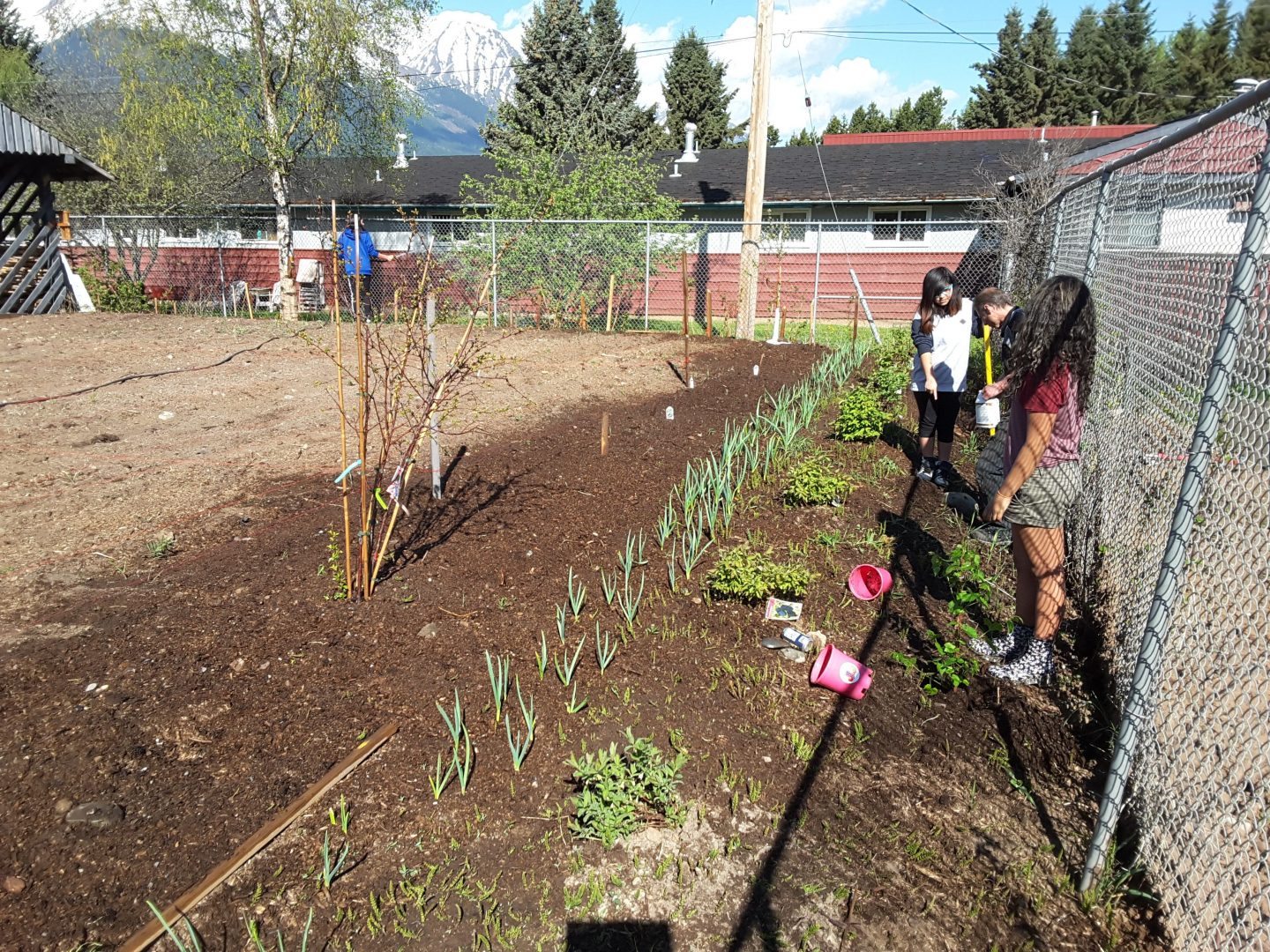Smithers Secondary School is located ~800 km north of Vancouver BC. Our outdoor frost-free season for vegetables typically spans from the end of May to the Middle of September. This poses a particular challenge to a school as much of the normal growing season takes place outside of school time. As a result food production at our school requires innovative solutions.
Over the past number of years we have utilized a number of growing methods to both demonstrate how to successfully grow fresh produce in the north and to ensure that our students have regular access to quality produce. At present Smithers Secondary school has a geodesic year-round greenhouse, a three-season greenhouse, an approximately 2000 square foot mulch garden and many classes also have sprout trays in the classroom. In all we produce over 35 different types of vegetables, herbs, fruits and berries for use in our culinary arts program, for student consumption and, at times, for sale. Remarkably, this has almost all been accomplished without having a school budget, but rather from the hard work of a few staff, district permission for use of the space, generous grant opportunities, community support, student contributions and some self-sustaining sales.
As a result of these efforts students at Smithers Secondary have had a unique opportunity to experience observing and participating in local food production. Further, students and staff have learned how to test the quality of their own produce and plants through the use of refractometers combined with learning about their health and how it relates to the food they eat.
In all, this has resulted from collaboration between 6 teachers and their classes over 12 months and has included over ½ of the student population of SSS in preparing/construction, planting, tending, harvesting, preserving, cooking, and consuming produce. We have also demonstrated composting techniques, reclamation of under-utilized educational space and beautification of school grounds to students, staff, and many community groups and individuals receiving local, provincial and national recognition. This has provided hands-on experiential learning of real world, authentic pedagogy and enhanced student work habits.
Students are experiencing new produce and cooking techniques, understanding the importance of locally grown products, experiencing the simple joys of gardening and growing their own produce, realizing how easy it can be and how little space is really needed. In the end we believe that healthy people require good air, water and food. By producing food locally students are able to participate in reducing food transportation emissions, learning sustainable water use and production of quality food. By utilizing fresh, school grown produce to enhance student learning, we are supporting curricular outcomes, strengthening student-teacher bonds and contributing simple solutions to preserving our planet through local sustainable and innovative practices.
What would farming be without challenges? Is it not the challenges we face that lead to innovation? Our most significant challenge is the limited growing season in combination with school being out of session during the main growing season. This has resulted in the use of a variety of growing structures and engaging in community partnerships to assist with the tending of our garden spaces through the summer months.
The second most significant challenge is that extra-curricular time is limited, as is finding time to work and coordinate between all shareholders of the project. Due to declining enrollment, there are limited opportunities to include farming activities in curricular programs. This requires staff, and in some cases students, to work outside of the school timetable. This is especially challenging as we are a rural community and many students are required to take a school bus limiting participation opportunities outside of regular school timetable. This has resulted in teachers creatively working the project into different courses so that it parallels the curricular outcomes thus increasing student participation opportunities.
The third most significant challenge is the lack of curricular focus on sustainable food production. Quality food is something that we all need. Further, we all have a responsibility to find local solutions to global issues such as climate change. This project has provided a basis for teaching the key social responsibility concepts of sustainability, self-sufficiency, and healthy living.
The staff at Smithers Secondary have worked, and will continue to work, hard to integrate the opportunities presented by this project into existing curriculum. In the end, producing and consuming quality food combined with the numerous peripheral benefits, is a life requirement that is not fully valued in our curriculum.
As budgets shrink schools face significant challenges in providing quality and diverse hands-on learning opportunities for students. This drives the need for teachers to be creative and efficient when developing ways to meet and enhance curricular requirements. This project has provided an excellent and relevant learning situation that has developed a link between students, staff, the school and the community.
Further, an extra level of respect for the school community has developed as evidenced by little to no vandalism, appreciation of having school grown produce in the foods class, students volunteering to assist in the creation and maintenance of the gardens and, teachers coordinating with project leads to incorporate the project into their classes.
Students and Staff involved have expressed having a greater sense of pride in their school environment while parents and community members support the importance of students being educated in meaningful, hands-on learning. Ultimately, students and the community are becoming increasingly aware of the quality and health hazards of the foods they eat as well as the huge impact that local food production has on their overall health and wellbeing.

